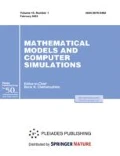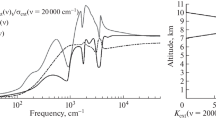Abstract
The paper describes a block for calculating the Earth’s natural atmospheric radiation in the IR range developed for the general circulation model simulating the lower and middle atmosphere. This block uses the new parametrization of molecular absorption in the frequency range from 10 to 2000 cm−1 at the altitude ranging from the Earth’s surface to 76 km. The algorithm for constructing this parametrization takes into account the change in the gas composition of the atmosphere with altitude and has some other significant advantages. In addition, for the numerical solution of the radiation transfer equation, the discrete ordinate method and the computational zenith angle grid with the step of about nine degrees are used. The results of the line-by-line calculations of the Earth’s internal atmospheric radiation field are compared with the results of the calculations performed using parametrization, and it is shown that the presented parametrization is accurate in the lower and middle atmosphere both in the absence of clouds and in the presence of cloud layers with a significant optical thickness.


Similar content being viewed by others
REFERENCES
Yu. M. Timofeev and A. V. Vasilev, Theoretical Foundations of Atmospheric Optics (Nauka, St. Petersburg, 2003) [in Russian].
K. Ya. Kondratev, Actinometry (Gidrometeoizdat, Leningrad, 1965) [in Russian].
Kuo-Nan Lion, An Introduction to Atmospheric Radiation (Academic, New York, 1980).
T. A. Sushkevich, Mathematical Models of Radiation Transfer (BINOM, Labor. Znanii, Moscow, 2006) [in Russian].
S. D. Tvorogov, “Some aspects of the problem of representation of the absorption function by a series of exponents,” Atmos. Ocean. Opt. 7 (3), 165–171 (1994).
S. D. Tvorogov, L. I. Nesmelova, and O. B. Rodimova, “Representation of the transmission function by the series of exponents,” Atmos. Ocean. Opt. 9, 239–242 (1996).
L. I. Nesmelova, O. B. Rodimova, and S. D. Tvorogov, “Calculation of transmission functions in near infrared region using series of exponents,” Atmos. Ocean. Opt. 10, 923–927 (1997).
L. I. Nesmelova, O. B. Rodimova, and S. D. Tvorogov, “Application of exponential series to calculation of radiative fluxes in the molecular atmosphere,” Atmos. Ocean. Opt. 12, 735–739 (1999).
S. D. Tvorogov, “Application of exponential series to frequency integration of the radiative transfer equation,” Atmos. Ocean. Opt. 12, 730–734 (1999).
S. D. Tvorogov and O. B. Rodimova, “Calculation of transmission functions at small pressures,” Atmos. Ocean. Opt. 21, 797–803 (2008).
B. A. Fomin, “Method for parameterization of gas absorption of atmospheric radiation giving the k-distribution with minimum number of terms,” Atmos. Ocean. Opt. 16, 244–246 (2003).
B. A. Fomin, “A k-distribution technique for radiative transfer simulation in inhomogeneous atmosphere: 1. FKDM, fast k-distribution model for the longwave,” J. Geophys. Res. 109, D02110 (2004).
B. A. Fomin and P. M. Correa, “A k-distribution technique for radiative transfer simulation in inhomogeneous atmosphere: 2. FKDM, fast k-distribution model for the shortwave,” J. Geophys. Res. 110, D02106 (2005).
E. J. Mlawer, S. J. Taubman, P. D. Brown, M. J. Iacono, and S. A. Clough, “Radiative transfer for inhomogeneous atmospheres: RRTM, a validated correlated-k model for the longwave,” J. Geophys. Res. D 102, 663–682 (1997).
S. Cusack, J. M. Edwards, and J. M. Crowther, “Investigating k-distributing method for parametrizing gaseous absorption in the Hadley Centre Climate Model,” J. Geophys. Res. 104, 2051–2057 (1999).
T. Nakajima, M. Tsukamoto, Y. Tsushima, A. Numaguti, and T. Kimura, “Modeling of the radiation process in an atmospheric general circulation model,” Appl. Opt. 39, 4869–4878 (2000).
R. J. Hogan, “The full-spectrum correlated-k method for longwave atmospheric radiative transfer using an effective Planck function,” J. Atmos. Sci. (2010).
B. N. Chetverushkin, Mathematical Modeling of Problems of Radiating Gas Dynamics (Nauka, Moscow, 1985) [in Russian].
A. V. Shilkov and M. N. Gerthev, “Verification of the Lebesgue averaging method,” Math. Models Comput. Simul. 8, 93–107 (2016).
B. N. Chetverushkin, I. V. Mingalev, K. G. Orlov, V. M. Chechetkin, V. S. Mingalev, and O. V. Mingalev, “Gas-dynamic general circulation model of the lower and middle atmosphere of the Earth,” Math. Models Comput. Simul. 10, 176–185 (2018).
I. V. Mingalev, E. A. Fedotova, and K. G. Orlov, “Parameterization of the infrared molecular absorption in the Earth’s lower and middle atmosphere,” Atmos. Ocean. Opt. 31, 582–589 (2018).
L. S. Rothman et al., “The HITRAN2012 molecular spectroscopic database,” J. Quant. Spectrosc. Rad. Transfer 130, 4–50 (2013).
E. J. Mlawer et al., “Development and recent evaluation of the MT CKD model of continuum absorption,” Phylos. Trans. R. Soc. 370, 2520–2556 (2012).
N. I. Ignat’ev, I. V. Mingalev, A. V. Rodin, and E. A. Fedotova, “A new version of the discrete ordinate method for the calculation of the intrinsic radiation in horizontally homogeneous atmospheres,” Comput. Math. Math. Phys. 55, 1713–1726 (2015).
A. A. Samarskii and E. S. Nikolaev, Methods for Solving Grid Equations (Nauka, Moscow, 1978) [in Russian].
I. V. Mingalev, E. A. Fedotova, and K. G. Orlov, “The effect of optically thick cloud layers on heating of the atmosphere self emission,” Sovrem. Probl. Distants. Zondir. Zemli Kosmosa, 14 (5), 100-108 (2017).
R. A. McClatchey, H.-J. Bolle, and K. Ya. Kondratyev, “A preliminary cloudless standard atmosphere for radiation computation,” World Climate Research Programme WCP112, WMO/TD-No. 24 (Int. Assoc. Meteorol. Atmos. Phys., Radiation Commission, 1986).
V. A. Gasilov, P. A. Kuchugov, O. G. Olkhovskaya, and B. N. Chetverushkin, “Solution of the self-adjoint radiative transfer equation on hybrid computer systems,” Comput. Math. Math. Phys. 56, 987–995 (2016).
Author information
Authors and Affiliations
Corresponding author
Ethics declarations
The authors declare that they have no conflicts of interest.
Additional information
Translated by I. Pertsovskaya
Rights and permissions
About this article
Cite this article
Chetverushkin, B.N., Mingalev, I.V., Fedotova, E.A. et al. Calculating the Natural Atmospheric Radiation Using the General Circulation Model of the Earth’s Lower and Middle Atmosphere. Math Models Comput Simul 12, 803–815 (2020). https://doi.org/10.1134/S207004822005004X
Received:
Revised:
Accepted:
Published:
Issue Date:
DOI: https://doi.org/10.1134/S207004822005004X




